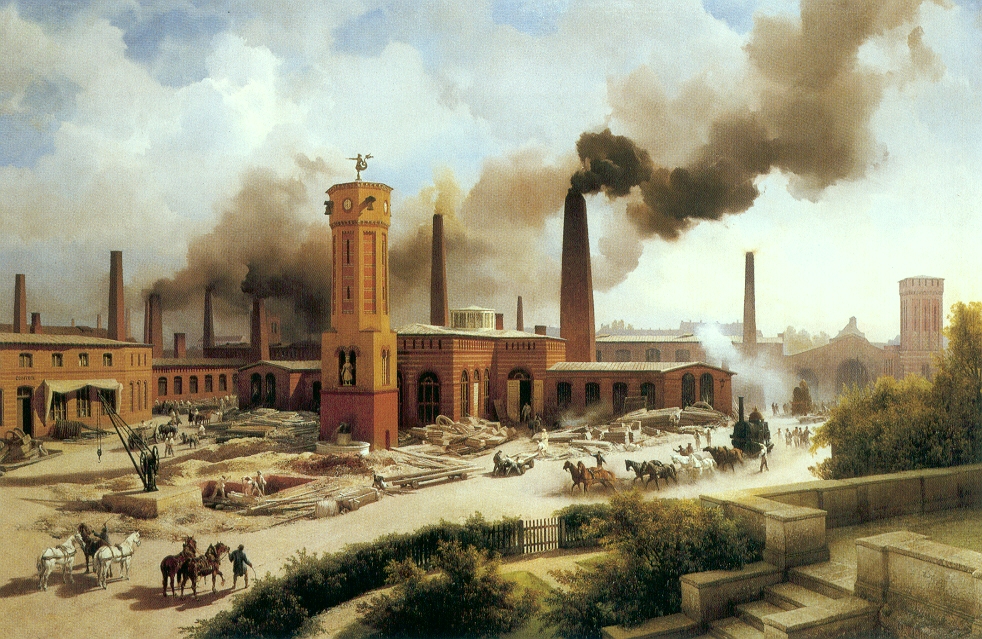Feuerland on:
[Wikipedia]
[Google]
[Amazon]
Feuerland was a popular 19th-century designation for the industrial nucleus of
 For example, in 1804 the Royal Prussian Iron Foundry started producing in
For example, in 1804 the Royal Prussian Iron Foundry started producing in
Berlin
Berlin ( , ) is the capital and largest city of Germany by both area and population. Its 3.7 million inhabitants make it the European Union's most populous city, according to population within city limits. One of Germany's sixteen constitue ...
. It was located in the historic Oranienburger Vorstadt
Oranienburger Vorstadt is a historic district of Berlin in what is now the northwestern part of Mitte and the adjacent Gesundbrunnen area, in the modern Mitte borough.
Geography
The former suburb was located between the Berlin-Spandau Ship C ...
section of Berlin in today’s district Berlin-Mitte
Mitte () (German for "middle" or "center") is a central locality () of Berlin in the eponymous district () of Mitte. Until 2001, it was itself an autonomous district.
Mitte proper comprises the historic center of Alt-Berlin centered on the chu ...
. The word literally means “land of fire”, but it is also a play on the German name for Tierra del Fuego
Tierra del Fuego (, ; Spanish for "Land of the Fire", rarely also Fireland in English) is an archipelago off the southernmost tip of the South American mainland, across the Strait of Magellan. The archipelago consists of the main island, Isla G ...
.
History
Many companies in the emerging metalworking and mechanical engineering industries settled in the area northeast of the Oranienburger Tor, one of the gates of the 18th-centuryBerlin Customs Wall
The Berlin Customs Wall (German: "Berliner Zoll- und Akzisemauer", literally ''Berlin customs and excise wall'' the German term had been originally "Akzisemauer" / excise wall but with the fading knowledge of the term "excise" most references inco ...
, between Chausseestraße (today‘s Torstraße), Gartenstraße and Liesenstraße.
 For example, in 1804 the Royal Prussian Iron Foundry started producing in
For example, in 1804 the Royal Prussian Iron Foundry started producing in Invalidenstraße
The Invalidenstraße is a street in Berlin, Germany. It runs east to west for through the districts of Mitte and Moabit. The street originally connected three important railway stations in the northern city centre: the Stettiner Bahnhof (today N ...
. In 1826 Franz Anton Egells set up his iron foundry and engineering works at Chausseestraße 3/4, later expanding it to include Chausseestraße 5/6. In 1837 August Borsig
Johann Karl Friedrich August Borsig (23 June 1804 – 6 July 1854) was a German businessman who founded the ''Borsig-Werke'' factory.
Borsig was born in Breslau (Wrocław), the son of cuirassier and carpenter foreman Johann George Borsig. After ...
established a factory at Chausseestraße 1–3, to be followed in 1839 by Friedrich Adolf Pflug at Chausseestraße 7–9. In 1842 Johann Friedrich Ludwig Wöhlert
Johann Friedrich Ludwig Wöhlert (16 September 1797 – 31 March 1877) was a German businessman. Johann Wöhlert was born on 16 September 1797 in Kiel in north Germany. Trained as a joiner, in 1818 Wöhlert went to Berlin. Here he worked until 183 ...
started an iron foundry and engineering works at Chausseestraße 29.
By 1847, 33 metalworking companies with over 3000 employees were located in this closely circumscribed area, and in 1852 the iron foundry and engineering works of Louis Victor Robert Schwartzkopff
Louis Victor Robert Schwartzkopff (5 June 1825 - 7 March 1892) was a German industrialist and founder of the Berliner Maschinenbau (BMAG) mechanical engineering company, chiefly known as manufacturer of steam locomotives.
Life
Louis Schwartzk ...
also started operations there.
Since all these businesses made heavy use of fire in the production process and huge amounts of smoke poured into the sky from the diverse chimneys, this part of the city was informally given the now forgotten name “Feuerland”.
As the city grew, these metalworking companies were unable to expand and either ceased production or by 1880 had moved to what was then the city outskirts, first to Moabit
Moabit () is an inner city locality in the borough of Mitte, Berlin, Germany. As of 2016, around 77,000 people lived in Moabit. First inhabited in 1685 and incorporated into Berlin in 1861, the former industrial and working-class neighbourhood i ...
and then after 1900 further out to Spandau
Spandau () is the westernmost of the 12 boroughs () of Berlin, situated at the confluence of the Havel and Spree rivers and extending along the western bank of the Havel. It is the smallest borough by population, but the fourth largest by land ...
or Reinickendorf
Reinickendorf () is the twelfth borough of Berlin. It encompasses the northwest of the city area, including the Berlin Tegel Airport, Lake Tegel, spacious settlements of detached houses as well as housing estates like Märkisches Viertel.
Subdivi ...
. Today, only a few street names (Borsigstraße, Pflugstraße, Schwartzkopffstraße and Wöhlertstraße) as well as a building or two remain as a memorial to those times. A panel at the corner of Chauseestraße and Tieckstraße provides information about Berlin's Feuerland.
References
{{coord, 52, 32, 0, N, 13, 23, 0, E, display=title 19th century in Berlin Economy of Berlin Industrial parks in Germany Buildings and structures in Mitte